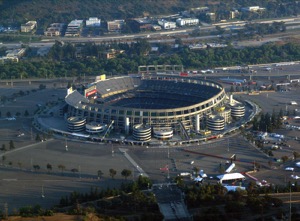
Finding a way to keep the Chargers in San Diego is complicated. Arithmetic and self-interest are not, which is why I think the key players are making a ballot initiative more complicated than it needs to be. If you need two-thirds of voters to back a funding plan, tell most voters that it won’t cost them a dime.
One analysis suggests that the cost of keeping the Chargers would amount to $40 dollars annually from each San Diego County household for twenty years. (http://www.utsandiego.com/news/2015/jan/31/no-stadium-business-case-chargers-public-help/)
That’s too much for many working San Diegans trying to make ends meet in one of America’s most expensive cities. They would almost certainly vote to defeat any sort of flat fee or broad based tax, and I would join them.
For simplicity, let’s assume that anyone who doesn’t have to pay the tax would vote for it. Leaving two-thirds of San Diego households out of the tax would require $120/year from the remaining third. If those were the highest income households, the American Community Survey suggests that 88 percent would make $100,000/year or more, with the others just below that threshold. (http://www.sandag.org/uploads/publicationid/publicationid_1677_14619.pdf)
Not everyone in that bracket will agree with me that the Chargers are worth $120 per year, but that’s OK for two reasons. First, $120/year would be the average, not actual, charge as long as a tax is used instead of a fee. A “flat tax” starting around $100,000 would leave those near that threshold paying less than $120/year because those at the top would pay more. A sales tax could target luxury items that would allow people to use their purchases to choose what they pay, even effectively opting out if they want.
Second, in our simplistic model, we don’t need the votes of anyone being taxed because the other two-thirds are voting “yes.” If that gives you “tyranny of the majority” chills, we can adjust the numbers. An income threshold of $75,000/year would include 43 percent of households. In that scenario, nearly a quarter of those who would pay the tax (10 percent) would have joined the other 57 percent to ensure passage. The reality might be closer to a half of those taxed, as lower income households are less likely to vote.
I’m not an expert on local tax policy, so I don’t know if that’s the right mix. I do know that the Chargers aren’t a necessity, like infrastructure improvements. Unlike other sources of civic pride that are free to all, like Balboa Park and the beaches, tickets to a new Chargers stadium would be even further out of reach for many San Diegans, who might benefit from a move that decreased Sunday traffic and TV blackouts. The Chargers are a luxury, so any revenue plan should focus on those who can afford it. If it can’t get the support of most of the people who won’t have to pay and many of those who will, we can at least be sure it’s time to say good-bye.











